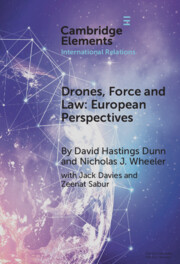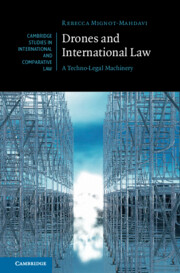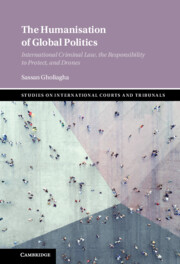60 results
Artificial intelligence in low-altitude flight: Developmental opportunity or ethical challenge?
-
- Journal:
- The Aeronautical Journal , First View
- Published online by Cambridge University Press:
- 03 March 2025, pp. 1-19
-
- Article
- Export citation
Environmental correlates of breeding outcomes in Endangered Grey Crowned Cranes Balearica regulorum in agricultural areas of KwaZulu-Natal, South Africa
-
- Journal:
- Bird Conservation International / Volume 35 / 2025
- Published online by Cambridge University Press:
- 16 January 2025, e2
-
- Article
-
- You have access
- Open access
- HTML
- Export citation
Returning the War to Russia: Drones and Discrimination in the Defense of Ukraine
-
- Journal:
- Ethics & International Affairs / Volume 38 / Issue 1 / Spring 2024
- Published online by Cambridge University Press:
- 01 October 2024, pp. 54-63
-
- Article
-
- You have access
- Open access
- HTML
- Export citation
Low-cost tree crown dieback estimation using deep learning-based segmentation
-
- Journal:
- Environmental Data Science / Volume 3 / 2024
- Published online by Cambridge University Press:
- 18 September 2024, e18
-
- Article
-
- You have access
- Open access
- HTML
- Export citation

Drones, Force and Law
- European Perspectives
-
- Published online:
- 04 December 2023
- Print publication:
- 18 January 2024
-
- Element
- Export citation
Above the law: Drones, aerial vision and the law of armed conflict – a socio-technical approach
-
- Journal:
- International Review of the Red Cross / Volume 105 / Issue 924 / December 2023
- Published online by Cambridge University Press:
- 15 November 2023, pp. 1690-1728
- Print publication:
- December 2023
-
- Article
-
- You have access
- Open access
- HTML
- Export citation
12 - Drone Warfare
- from Part V - Special Topics in Conflict
-
-
- Book:
- Understanding War and Peace
- Published online:
- 06 July 2023
- Print publication:
- 20 July 2023, pp 371-404
-
- Chapter
- Export citation
7 - Rituals of Sovereignty
-
- Book:
- Drones and International Law
- Published online:
- 31 May 2023
- Print publication:
- 13 July 2023, pp 182-210
-
- Chapter
- Export citation
1 - Drone Programs Reconfiguring War, Law, and Societies around Threat Anticipation
-
- Book:
- Drones and International Law
- Published online:
- 31 May 2023
- Print publication:
- 13 July 2023, pp 1-16
-
- Chapter
- Export citation
4 - Targeting Hostile Individuals
-
- Book:
- Drones and International Law
- Published online:
- 31 May 2023
- Print publication:
- 13 July 2023, pp 87-118
-
- Chapter
- Export citation
2 - Contexts
-
- Book:
- Drones and International Law
- Published online:
- 31 May 2023
- Print publication:
- 13 July 2023, pp 17-40
-
- Chapter
- Export citation

Drones and International Law
- A Techno-Legal Machinery
-
- Published online:
- 31 May 2023
- Print publication:
- 13 July 2023
Assessing the potential disturbance effects on the use of Unmanned Aircraft Systems (UASs) for European vultures research: a review and conservation recommendations
-
- Journal:
- Bird Conservation International / Volume 33 / 2023
- Published online by Cambridge University Press:
- 02 February 2023, e45
-
- Article
-
- You have access
- Open access
- HTML
- Export citation
Chapter 16 - War and Drones
- from Part III - Emerging Concepts
-
-
- Book:
- War and Literary Studies
- Published online:
- 15 January 2023
- Print publication:
- 05 January 2023, pp 261-277
-
- Chapter
- Export citation
The unique value proposition for using drones to map coastal ecosystems
-
- Journal:
- Cambridge Prisms: Coastal Futures / Volume 1 / 2023
- Published online by Cambridge University Press:
- 12 December 2022, e6
-
- Article
-
- You have access
- Open access
- HTML
- Export citation
Rethinking direct participation in hostilities and continuous combat function in light of targeting members of terrorist non-State armed groups
-
- Journal:
- International Review of the Red Cross / Volume 105 / Issue 923 / August 2023
- Published online by Cambridge University Press:
- 07 September 2022, pp. 1028-1046
- Print publication:
- August 2023
-
- Article
- Export citation
7 - Killing the Individual Human Being via Drones
-
- Book:
- The Humanisation of Global Politics
- Published online:
- 25 August 2022
- Print publication:
- 01 September 2022, pp 160-202
-
- Chapter
- Export citation

The Humanisation of Global Politics
- International Criminal Law, the Responsibility to Protect, and Drones
-
- Published online:
- 25 August 2022
- Print publication:
- 01 September 2022
5 - AI and Contract Performance
- from Part II - AI: Contracting and Corporate Law
-
-
- Book:
- The Cambridge Handbook of Artificial Intelligence
- Published online:
- 28 July 2022
- Print publication:
- 11 August 2022, pp 59-73
-
- Chapter
- Export citation
Artificial Intelligence, Autonomous Drones and Legal Uncertainties
-
- Journal:
- European Journal of Risk Regulation / Volume 14 / Issue 1 / March 2023
- Published online by Cambridge University Press:
- 03 August 2022, pp. 31-48
-
- Article
-
- You have access
- Open access
- HTML
- Export citation


